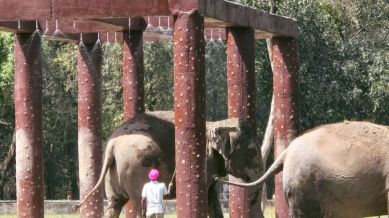Stay updated with the latest - Click here to follow us on Instagram
Mohali’s Chhatbir Zoo plans to beat the heat with showers, coolers, and special diets for its inhabitants
New sprinkler showers have also been installed especially for elephants like Hema and Maya.

With summer already making its presence felt, the management at Mahendra Chaudhary Zoological Park, aka Chhatbir Zoo, in Mohali has started taking steps to shield animals from the scorching heat. From installing coolers and air circulator fans in enclosures to serving fruit cream and glucose-based drinks, the zoo is leaving no stone unturned to ensure the well-being of its inhabitants.
Coolers and air circulators are also being installed in enclosures of tigers, leopards, lions, bears, and even dogs and cats, said Harpal Singh, range officer, Chhatbir Zoo. “Our focus is to keep their (animals) surroundings cool, dry, and mosquito-free,” he added.
To beat the heat, Himalayan bears will enjoy fruit cream, while other animals will be served glucose daily. Ice slabs will also be added to water ponds. Additionally, for elephants and deer, ponds are being cleaned and replenished regularly, and vitamin-rich water is being added for better health.
Harpal said enclosures are being wrapped with 75 per cent density agro-nets and jute mats to bring down internal temperatures. Temporary bamboo and wooden huts are also being constructed for shade and for mosquito-proofing all windows are being covered with mesh screens.
“We have started feeding fruit cream to bears and are now giving watermelons to monkeys, elephants, and bears. Glucose will be mixed in drinking water for all carnivores and herbivores. During summer, we’ll replace bananas with papayas and spinach leaves with cabbage. Birds are also being fed cucumbers for hydration,” the zoo official shared.
Bird cages are being shielded with agro-nets and jute mats, and “sprinkler showers are being introduced to help prevent heat stroke among birds,” Harpal added.
16 new animals from Assam Zoo welcomed
The range officer also revealed that 16 new animals from the Guwahati zoo in Assam have arrived. The animals, part of an exchange program, travelled 2,134 km across five states.
The newcomers include 4 mouse deer, 5 manipur deer (2 males, 3 females), 2 female leopards, 2 black bears (1 male, 1 female), 1 male hippopotamus, and 2 Burmese rock pythons — one of the world’s largest snake species reaching up to 23 feet in length and weighing over 200 pounds.
Initially, the animals will be kept in isolation to acclimatise them to the local environment before being exhibited to the public. The zoo has installed CCTV cameras for continuous monitoring.
The two female leopards aim to increase the leopard population, currently comprising only two males. “Their genetic diversity will enrich our breeding program,” Harpal added.
In return, Chhatbir Zoo has sent partridges, sparrows, blackbucks, and ducks to Assam Zoo as part of the exchange program.